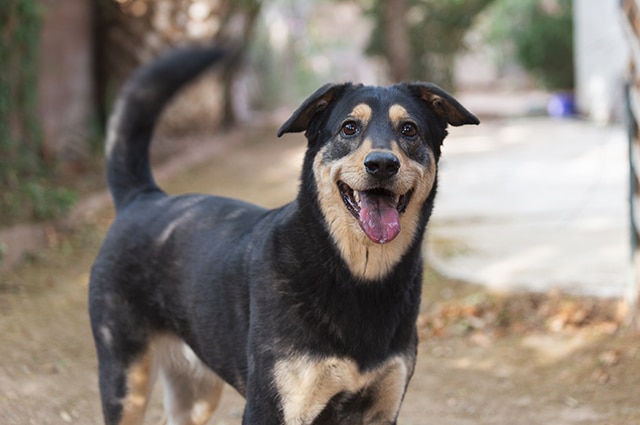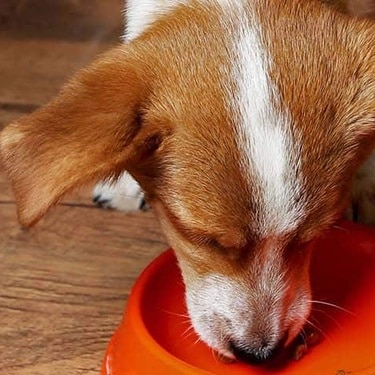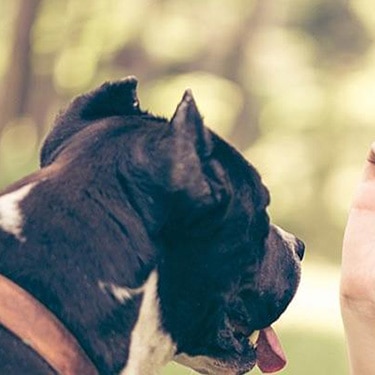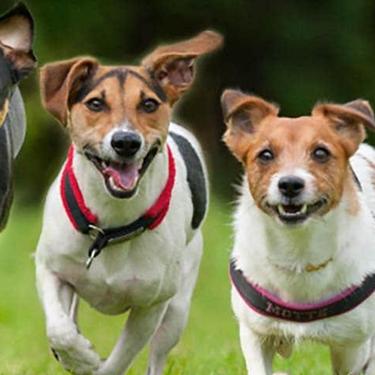

Have you ever caught your dog doing three complete circles before settling down for a bathroom break, or watched them cock their head at just the right angle when you ask if they want a treat? Perhaps you've witnessed your Great Dane cowering behind your legs at the sight of a Chihuahua with an attitude problem, or found yourself mesmerised by your pup's committed vigil at the front door, waiting for your return.
These quirky behaviours are what make our dogs uniquely lovable—but they're also windows into understanding what makes our companions tick. Whilst many behaviours are common (we see them all the time), not all of them are necessarily normal (healthy or beneficial). As pet parents, learning to distinguish between the adorable, the concerning, and the downright fascinating can help us provide the best care for our dogs whilst celebrating everything that makes them wonderfully and inexplicably themselves.
Let's explore some of the most questioned dog behaviours trending across social media and veterinary clinics alike, separate fact from fiction, and help you understand when to simply smile and when to take action.
The Head Tilt - What's Your Dog Really Saying?
Few things melt hearts faster than a dog tilting their head whilst you're talking to them. This endearing gesture has launched a thousand viral videos, but what's actually happening behind those attentive eyes?
Dogs tilt their heads for several fascinating reasons. According to canine behaviour studies, the head tilt may help dogs better localise sounds by adjusting the position of their ear canals. It's their way of fine-tuning their already impressive hearing to work out exactly what you're saying - or more accurately, whether what you're saying involves the words "walk," "treat," or "dinner."
There's also a visual component. Dr Stanley Coren's research from the University of British Columbia suggests that dogs with longer muzzles might tilt their heads to see around their snouts and get a better view of our facial expressions. After all, they've spent thousands of years evolving alongside humans, learning to read our emotions and intentions.
In most cases, the head tilt is perfectly normal and simply demonstrates your dog's attempt to understand you better. However, if you notice persistent head tilting accompanied by loss of balance, circling, or unusual eye movements, it's worth consulting your vet, as these could indicate ear infections or vestibular issues.
Those Puppy Eyes & Tail Wags - Manipulation or Love?
Here's something that might surprise you: your dog has actually evolved specific facial muscles that wolves don't have, specifically to communicate with you. Research from the University of Portsmouth published in 2019 revealed that dogs have developed the ability to raise their inner eyebrows, creating those irresistible "puppy dog eyes" that wolves physically cannot replicate.
Is it manipulation? In the most endearing way possible, yes. Over thousands of years of domestication, dogs who could better communicate with humans through facial expressions were more likely to receive care, food, and a warm place by the fire. It's evolutionary success written all over their expressive faces.
Tail wagging is another sophisticated communication tool often misunderstood as a simple sign of happiness. Recent veterinary behavioural studies show that the direction, speed, and height of a tail wag all convey different messages. A broad, sweeping wag generally indicates happiness, whilst a high, stiff wag might signal arousal or potential aggression. Even more intriguing, Italian researchers discovered that dogs tend to wag more to the right when they're happy (left brain activation) and more to the left when they're anxious (right brain activation).
Learning to read these subtle signals helps you understand what your dog is truly communicating. If those puppy eyes are accompanied by a relaxed body and gentle tail wag, that's genuine affection. If they seem tense despite the tail movement, something else might be going on.

The Door Vigil - Why Does My Dog Wait There?
If you've ever returned home to find your dog stationed by the door, you're witnessing one of the most touching demonstrations of canine devotion. But what drives this behaviour?
Dogs are creatures of routine with an impressive internal clock. Studies show they can anticipate regular events with remarkable accuracy, likely using a combination of circadian rhythms, environmental cues, and yes, even detecting subtle changes in household scents as the day progresses. When you typically arrive home at 5:30 PM, your dog knows it's "almost 5:30" long before you turn into your street.
This waiting behaviour also stems from attachment and social bonding. In the wild, canines are pack animals who depend on each other for survival. Your departure represents a temporary break in the pack, and your return restores order to their world. For most dogs, this is a healthy expression of their bond with you.
That said, excessive door monitoring accompanied by destructive behaviour, constant vocalisation, or signs of distress (drooling, pacing, refusing to eat) might indicate separation anxiety rather than simple anticipation. If your dog seems genuinely distressed rather than patiently waiting, consider consulting a veterinary behaviourist who can help develop a management plan.
The Pre-Poop Ritual - Why All That Sniffing?
Perhaps no dog behaviour has sparked more curiosity (and impatience during winter walks) than the elaborate pre-toileting routine. Your dog circles, sniffs, circles again, sniffs some more, and finally does their business. What on earth is going on?
The sniffing component serves multiple purposes. Dogs are gathering information about who else has been in the area, establishing or reinforcing territory, and essentially "reading the news" through their remarkably sensitive noses. With up to 300 million scent receptors compared to our measly 6 million, dogs perceive a rich tapestry of olfactory information we can't begin to imagine.
But here's where it gets truly fascinating: a 2013 study published in Frontiers in Zoology found that dogs prefer to align their bodies along the north-south axis of Earth's magnetic field when toileting. Researchers observed 70 dogs across 1,893 defecations and found they actively avoided the east-west alignment. Whilst scientists are still investigating why this matters to dogs, it suggests they can detect Earth's magnetic field - a sense called magnetoreception.
Sudden changes in your dog's toileting routine, however, warrant attention. Straining, frequent attempts with little production, or changes in stool consistency might indicate digestive issues. Quality nutrition plays a crucial role in maintaining healthy digestion - foods formulated with prebiotic fibres and easily digestible ingredients can support optimal gut health and comfortable, regular bowel movements.

Rescuers at Heart - The Hero Instinct
Scroll through social media and you'll find countless videos of dogs rescuing various animals - cats from precarious situations, birds caught in netting, other dogs in distress, and even humans facing danger. This hero instinct isn't just heartwarming content; it reveals something profound about canine empathy and social cognition.
Looking into canine behaviour suggests dogs possess emotional contagion - the ability to "catch" emotions from others, both human and animal. When they perceive distress, many dogs instinctively respond with helping behaviours. This likely evolved from their pack mentality, where cooperation and mutual aid increased survival chances.
Dogs have been documented rescuing a surprising variety of animals. There are verified accounts of dogs saving cats from drowning, alerting humans to trapped wildlife, protecting smaller animals from predators, and even attempting to rescue other dogs from perceived danger (sometimes misreading play for distress).
What's particularly interesting is that this behaviour appears across breeds and isn't limited to traditional "working" or "service" breeds. A suburban Labrador is just as likely to display rescue behaviour as a Border Collie, suggesting it's a fundamental aspect of canine social cognition rather than trained response.
The key is distinguishing between genuine rescue behaviour and normal pack protectiveness or, occasionally, resource guarding. True rescue behaviour involves intervention in situations where the dog has nothing to gain personally and may involve risk to themselves. That's empathy in action.
Licking Everything - Normal Grooming or Problem?
Dogs are naturally grooming creatures, but when does normal self-care cross into concerning territory? The answer depends on frequency, intensity, and what they're licking.
Normal grooming includes:
Licking paws after walks to clean them
Occasional face and body grooming
Brief attention to minor scrapes or cuts
Mutual grooming with other household dogs
Problematic licking includes:
Excessive paw licking: This is one of the most common concerns veterinarians hear about. Whilst dogs naturally clean their paws, constant licking that leads to staining, hair loss, or raw skin typically indicates an underlying issue. Allergies (environmental or food-related), anxiety, boredom, or pain from arthritis or injuries can all trigger obsessive paw licking. Australian pet owners should be particularly aware during spring when grass seeds and environmental allergens peak.
Private area licking: Whilst dogs naturally keep themselves clean, excessive attention to genital areas may signal urinary tract infections, bladder stones, or blockages in male dogs. This behaviour shouldn't be dismissed as "just grooming."
Ear grooming (either their own or another dog's): Dogs can't reach their own ears easily, but if you notice them constantly shaking their head or rubbing their ears, or if they're obsessively licking another pet's ears, ear infections or mites might be present. Ear infections are particularly common in breeds with floppy ears or dogs who swim frequently.
The skin and coat condition often reflects overall health, including digestive wellness. Nutrition formulated with optimal levels of omega-6 fatty acids and vitamin E can support healthy skin from the inside out, potentially reducing some licking behaviours related to skin irritation.
If your dog's licking seems excessive or is creating sores, it's time for a veterinary visit to rule out medical causes before assuming it's purely behavioural.
Tail Chasing & Tail Chewing - Play or Problem?
Watching a puppy discover their tail and engage in an enthusiastic chase can be entertaining. But when does this playful behaviour become something more concerning?
Tail chasing in young puppies is often simple play - they've discovered this fascinating moving object and want to catch it. A few spins here and there, usually ending with the puppy becoming distracted by something else, is perfectly normal developmental behaviour.
Compulsive tail chasing in older dogs, however, tells a different story. When a dog becomes fixated on their tail, spinning repeatedly without easily redirecting, or doing so until exhausted, it may indicate:
Obsessive compulsive disorder (yes, dogs can develop OCD - type diseases)
Inadequate mental stimulation or exercise
Attention-seeking behaviour that's been inadvertently reinforced
In some cases, neurological issues
Tail chewing is almost always problematic and warrants investigation. Dogs might chew their tails due to:
Fleas or other parasites
Anal gland issues (discomfort radiates to the tail base)
Pain from tail injuries
Certain breeds, particularly Bull Terriers and German Shepherds, show a genetic predisposition toward compulsive behaviours, including tail chasing. If you notice your dog engaging in repetitive tail behaviours, especially if it's increasing in frequency or intensity, consult your vet to rule out medical causes before addressing it as a purely behavioural issue.
Big Dogs, Small Fears - Size Doesn't Matter
It's one of the more amusing ironies of dog ownership: your 40 kilogram Labrador retreating behind you at the approach of a 3 kilogram terrier with an attitude. But this behaviour, whilst comical, reveals important truths about canine psychology.
Size and confidence aren't correlated in the dog world. Fearfulness in large dogs toward smaller dogs typically stems from several factors:
Socialisation experiences: Dogs who weren't properly socialised with various sizes and types of dogs during their critical developmental period (roughly 3-14 weeks of age) may find unfamiliar presentations intimidating. A dog who grew up only around similar-sized breeds might genuinely be confused or concerned by a tiny dog behaving assertively.
Energy and intensity: Small dogs often move quickly, make high-pitched vocalisations, and display bold behaviours that can be overwhelming. From a large dog's perspective, this unpredictable, intense energy can be concerning - they're not sure how to read or respond to it.
Past negative experiences: One unpleasant encounter with a small dog can create lasting wariness. If your large dog was snapped at by a small dog as a puppy, they may generalise that fear to all small dogs.
Gentle temperament: Some large breeds are simply soft-natured and avoid conflict. What looks like fear might actually be polite deference or a desire to avoid confrontation.
The key is not to reinforce fearful behaviour by coddling your anxious large dog, but rather to create positive associations with small dogs through controlled, calm exposures and rewarding confident behaviour. If your gentle giant struggles with this issue, consider working with a qualified dog trainer who uses positive reinforcement methods.
Understanding the difference between quirky and concerning is essential for proactive pet parenting. Here's your quick reference guide:
Normal & Healthy (Green Light):
Head tilting when listening to you
Occasional tail chasing in puppies during play
Waiting by the door around your usual arrival time
Sniffing and circling before toileting
Brief grooming sessions
Using puppy eyes to request treats or attention
Showing caution around unfamiliar situations
Watch & Monitor (Amber Light):
Changes in typical behaviour patterns
Increased frequency of previously occasional behaviours
Mild licking that's becoming more frequent
Door waiting that extends longer before and after your arrival
Tail chasing that's becoming more frequent but still distractible
Time to Call the Vet (Red Light):
Head tilting accompanied by loss of balance or unusual eye movements
Compulsive tail chasing that's difficult to interrupt
Tail chewing creating wounds or hair loss
Constant paw licking causing staining, baldness, or sores
Excessive licking of private areas or scooting
Signs of distress rather than patience when waiting (destruction, constant vocalisation)
Straining or changes in toileting habits
Sudden fear or aggression that's out of character
Any behaviour change accompanied by lethargy, appetite loss, or physical symptoms
Understanding your dog's behaviours is only part of responsible pet parenting - creating an environment that supports their physical and mental wellbeing is equally important.
Environmental enrichment: Puzzle toys, sniff mats, and regular training sessions provide mental stimulation that can reduce compulsive behaviours born from boredom. Australian pet owners are fortunate to have access to numerous dog-friendly spaces perfect for enriching walks.
Routine and structure: Dogs thrive on predictability. Consistent feeding times, walk schedules, and bedtime routines reduce anxiety and create security.
Nutritional foundation: Quality nutrition forms the foundation of both physical and mental health. Properly balanced diets support everything from skin and coat condition to energy levels and cognitive function. When digestive health is optimal, many secondary issues like excessive licking may improve.
Regular health checks: Annual veterinary examinations catch potential issues before they become problems. Don't hesitate to book between scheduled check-ups if you notice behavioural changes.
Training and socialisation: Ongoing positive reinforcement training and safe social experiences help dogs develop confidence and appropriate responses to various situations.
Every head tilt, tail wag, and inexplicable circle before settling down is part of what makes our dogs uniquely lovable. These behaviours connect us to thousands of years of evolution, pack dynamics, and the special relationship between humans and dogs that exists nowhere else in nature.
The key to excellent pet parenting isn't preventing all unusual behaviours - it's knowing your individual dog well enough to recognise when something shifts from quirky to concerning. That Great Dane hiding behind you from the Chihuahua? Probably fine (and definitely amusing). That same dog suddenly hiding from everything? Time for a chat with your vet.
Observe your dog, celebrate their individuality, and trust your instincts. You know your companion best. When you combine that knowledge with understanding the "why" behind common behaviours, you're equipped to provide the responsive, informed care that helps them thrive.
After all, life with dogs is better when we appreciate both their predictable routines and their wonderfully unpredictable personalities. Those quirks aren't just behaviours - they're love languages, communication attempts, and reminders that living with dogs means embracing a little beautiful chaos.




















